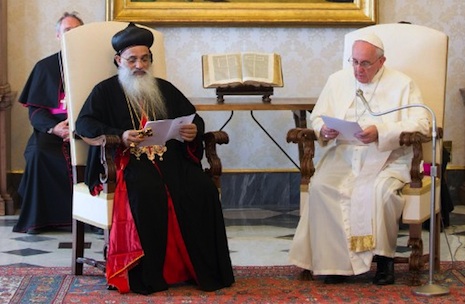One of the greats: Vale Luis Ruiz
by Fr. Michael Kelly, S.J.
Another of the greats of the Church of Asia has gone to his rest: Luis Ruiz, SJ. Fr. Luis Ruiz SJ. 1913-2011

He wasn’t a great intellectual whose writings illuminated the minds of many, like Karl Rahner; he wasn’t a public figure whose interventions shaped the destiny of nations, like Bishop Cisco Claver in the EDSA event in Manila in the 80s. He was giant because of the size of his heart- it was as big as a horse.
Coming to Macau as a refugee from China himself, he brought solace, comfort, food and shelter to thousands escaping persecution when Mao finally put paid to the corrupt and failed rule of Generalissimo Chiang Kai Shek.
Our report of his death in ucanews.com neglects to mention something of which Luis was very proud. As a Jesuit student for the priesthood and as part of his normal Jesuit training, he was first sent from Spain to Cuba, to teach in the Jesuit College in Havana. He loved it and was torn when asked to go to do his theological studies prior to ordination in Shanghai. He loved Cuba and the students he taught. He had a special affection for one who was the leading student of his year – President of the Sodality of Our Lady, champion of the baseball team and chief student officer in the school’s cadet corps: Fidel Castro. He found Fidel a most attractive young man and was proud of what he had achieved in ridding Cuba of the detested and irredeemably corrupt Battista regime.
But the genius of Luis was the way he reinvented himself as the carer for succeeding generations of those who were neglected and in need – the physically and intellectually disabled, those suffering from chronic diseases that separated them from families and communities with Hanson’s disease (leprosy) and in recent decades those with HIV Aids. Macau. the size of a postage stamp (12 square miles) and asleep under the benign neglect of its Portuguese colonial rulers for 50 of Luis’ 60 years there, was a hive of creativity and a base for extensive outreach to those in need, far distant from its borders.
Mao’s China was full of propaganda; the Chinese spin doctors claimed it was the first civilisation to have no gambling, no prostitution and to have eliminated many of the diseases that have plagued humanity since before history was recorded.
Prime among these was Hanson’s disease (Leprosy). With the wave of a magic wand, the Great Helmsman of the People (also known as Mao) had swept away that particular pestilence. Not so, of course.
Against all odds, it was Luis Ruiz’s extraordinary blend of dogged perseverance and utter sincerity that managed to have comfort and care brought to those suffering the disease in remote and secluded parts of southern China. In the face of official denial, the fear of losing face if the reality were exposed and his being a Catholic priest in very Communist China, Luis broke down all barriers to addressing the needs of the ill.
But an equally great challenge awaited him in the 80s and 90s – HIV/AIDS. The disease was officially non-existent in oh-so-pure China and therefore not to be acknowledged and treated. Not so for Luis and as our story reports, his work reached to many hundreds of centres for the length and breadth of China.
It was St Francis of Assisi who is alleged to have said “preach the Good News always. Use words if necessary.” Luis knew what that meant – he heard the Word of God and did it.
“Good night sweet prince, and may flights of angels sing thee to thy rest” (from Shakespeare’s Hamlet, Prince of Denmark)
Wisdom Story – 69

by Paul Brian Campbell,SJ
Once Buddha was walking from one town to another town with a few of his followers. This was in the initial days. While they were traveling, they happened to pass a lake. They stopped there and Buddha told one of his disciples, “I am thirsty. Do get me some water from that lake there.”
The disciple walked up to the lake. When he reached it, he noticed that right at that moment, a bullock cart started crossing through the lake. As a result, the water became very muddy, very turbid. The disciple thought, “How can I give this muddy water to Buddha to drink!”
So he came back and told Buddha, “The water in there is very muddy. I don’t think it is fit to drink.” After about half an hour, again Buddha asked the same disciple to go back to the lake and get him some water to drink. The disciple obediently went back to the lake.
This time too he found that the lake was muddy. He returned and informed Buddha about the same. After sometime, again Buddha asked the same disciple to go back. The disciple reached the lake to find the lake absolutely clean and clear with pure water in it. The mud had settled down and the water above it looked fit to be had. So he collected some water in a pot and brought it to Buddha.
Buddha looked at the water, and then he looked up at the disciple and said, “See what you did to make the water clean. You let it be…. and the mud settled down on its own – and you got clear water. Your mind is also like that! When it is disturbed, just let it be. Give it a little time. It will settle down on its own. You don’t have to put in any effort to calm it down. It will happen. It is effortless.”
Serapeum, Alexandria

The Serapeum (or Sarapeion) was a great temple dedicated to the Greek-Egyptian god Serapis in ancient Alexandria. Founded by Ptolemy I around 300 BC, it was infamously destroyed by Bishop Theophilus and his Christian mob in 391 AD.
Very little of the temple remains today, but visitors can enter the underground chamber that contained a cult image and the library and see some artifacts from the temple in the city’s Greco-Roman Museum.
History
Ptolemy I Soter was a childhood friend and trusted general of Alexander the Great, and eventually took over rule of Egypt after the Macedonian’s death. In an effort to unite the religions and cultures of the Egyptians and Greeks, Ptolemy I invented a new god, Serapis. He took a cult statue from Sinope and brought it to Alexandria, saying that he had been bidden to do so in a dream. According to tradition, the statue hopped in the Alexandrian ship after the locals proved unwilling to part with it. Upon its arrival in Alexandria, two religious experts in the employ of the king declared the statue to be Serapis.
Serapis was a combination of the traditional Egyptian gods Osiris and Apis, sprinkled with the attributes of the Hellenistic gods Zeus, Helios, Dionysus, Hades and Asklepius. Serapis was thus a supreme god of divine majesty and the sun (Zeus and Helios), fertility (Dionysos) the underworld and afterlife (Hades, Apis and Osiris) and healing (Asklepius). His connection to the afterlife and fertility were always primary.
Syncretism among Greek gods was a common practice, and there was already precedent for combining the Egyptian gods into one. Apis, the bull, was regard as the incarnation of Osiris, and Osiris was sometimes called “the bull of the west.” Indeed, the practice of combining the two names occured before Ptolemy: “Osirapis” was worshipped in Memphis and perhaps already in Alexandria.
The cult statue of Serapis was in classical Greek form, with no animal-headed Egyptian characteristics that would have been off-putting to the Greeks. Its iconography was that of Hades – with robe, Greek hairstyle, and beard – with a basket of grain on his head symbolizing fertility and his connection with Osiris, god of grain. At his feet was Cerberus, the three-headed dog of the Greek underworld. As described by Clement of Alexandria, the statue was made of a combination of many precious materials and had a dark-blue color.
To properly house the statue, Ptolemy I constructed the grand Serapeum on the acropolis of Alexandria (a modest hill). The temple was resembled the famous Serapeum at Memphis and was elevated on a great platform, over 100 steps high. It was made of gleaming marble and painted and gilded on the inside. The statue of Serapis was said to be so large that each hand touched the wall on either side.
Both pagan and Christian writers recorded that the temple officials employed some clever techniques to wow the crowds. A hidden magnet was fixed in the ceiling above the statue, so that the statue of Serapis appeared to rise up and remain suspended in the air of its own accord. And a small window was positioned so that a beam of sunlight touched the lips of Serapis in a kiss of renewal.
Alexandria was the center for the cult of Serapis, which spread throughout the Roman Empire as far as Britain, and pilgrimages were made to the Serapeum. Alexandria also became an early center of Christianity, and it was at the Serapeum that the conflict between the two communities was most dramatically played out.
According to tradition, it was at the Serapeum around 68 AD that the pagans of Alexandria dragged St. Mark to death. And in 391 AD, after Bishop Theophilus of Alexandria desecrated the temple and paraded its cult objects in the streets, the pagans rioted and barracaded themselves with Christian prisoners inside the Serapeum.
Probably as he had planned all along, Theophilus advanced on the temple with troops. He spared the lives of the pagans inside but completely destroyed the temple. The Christian mob hesitated before striking the image of Serapis, fearing the sky would come crashing down, but eventually a soldier struck the first blow with an axe. When the sky remained intact, Serapis’ head was chopped off and the statue was hacked to bits. To the delight of the Christians present, rats ran out of the hollow interior and the great Serapis was revealed to be nothing more than a man-made object.
As the temple itself was being torn down, heiroglyphics on the wall were noted by the Christians, who declared that the ankh symbol (which resembles the Christian cross) was a prophecy of the victory of Christianity. The Serapeum was replaced with a martyrs’ shrine and a church, and all other images and temples in Alexandria were systematically destroyed and replaced with crosses and churches.
What to See
Virtually nothing of the temple (or the church) remains on the site today, except for some above-ground rubble and an underground vault with niches that contained an annex of the Library of Alexandria. The sphinxes and “Pompey’s Pillar” on the site were not part of the Serapeum. A striking Apis bull statue, made of basalt stone, somehow survived from the Serapeum and is now in the Greco-Roman Museum. Also in the museum is a recently discovered dedicatory inscription from the temple.
Wisdom Story – 68

by Paul Brian Campbell,SJ
This story is by our friend, Rabindranath Tagore:
I have been seeking and searching God for as long as I can remember, for many many lives, from the very beginning of existence. Once in a while, I have seen him by the side of a faraway star, and I have rejoiced and danced that the distance, although great, is not impossible to reach. And I have traveled and reached to the star; but by the time I reached the star, God has moved to another star. And it has been going on for centuries.
The challenge is so great that I go on hoping against hope… I have to find him, I am so absorbed in the search. The very search is so intriguing, so mysterious, so enchanting, that God has become almost an excuse – the search has become itself the goal.
And to my surprise, one day I reached a house in a faraway star with a small sign in front of it, saying, “This is the house of God.” My joy knew no bounds – so finally I have arrived! I rushed up the steps, many steps, that led to the door of the house. But as I was coming closer and closer to the door, a fear suddenly appeared in my heart. As I was going to knock, I became paralyzed with a fear that I had never known, never thought of, never dreamed of. The fear was:
If this house is certainly the house of God, then what will I do after I have found him?”
Now searching for God has become my very life; to have found him will be equivalent to committing suicide. And what am I going to do with him? I had never thought of all these things before. I should have thought before I started the search: what am I going to do with God?
I took my shoes in my hands, and silently and very slowly stepped back, afraid that God may hear the noise and may open the door and say, “Where are you going? I am here, come in!” And as I reached the steps, I ran away as I have never run before; and since then I have been again searching for God, looking for him in every direction… and avoiding the house where he really lives. Now I know that house has to be avoided. And I continue the search, enjoy the very journey, the pilgrimage.
Bibliotheca Alexandrina, Alexandria

The Bibliotheca Alexandrina (Alexandrian Library) in Alexandria is a wonderful reincarnation of the famed ancient library of Alexandria. The original library held the largest collection of manuscripts in the world and was a great center of learning for 600 years until it burned down in the 3rd century. The dramatic new library, resembling an angled discus or a great sundial, was designed by a Norwegian architect and cost about $200 million.
The Library of Alexandria is of religious significance because of its original role as a temple, its historical association with such Christian theologians as Origen of Alexandria, and its collection of many religious manuscripts (including rare copies of the Qur’an). This article covers both the ancient and modern Alexandrian libraries together, as they share a common heritage and objectives.
History
Alexandria was selected by Alexander the Great as the capital of his empire in 320 BC, and it soon became the most powerful and influential city in the region. The original Library of Alexandria was founded in 288 BC by Ptolemy I (Soter) under the guidance of Demetrius of Phaleron. It was a temple to the muses (Mouseion in Greek; Museum in Latin) and functioned as an academy, research center, and library. The great thinkers of the age flocked to Alexandria to study and exchange ideas.
The original library was located in the royal district of the city, with an additional building for storage on the harbor, and a “daughter library” located in the Serapeum in the southwest part of the city. As many as 700,000 scrolls, the equivalent of more than 100,000 modern printed books, filled the shelves. The library was open to scholars from all cultures and both girls and boys. At the ancient library of Alexandria:
It is not clear exactly when the ancient Library of Alexandria was destroyed. It was probably badly damaged by fire during Julius Caesar’s conquest in 48 BC and may have been destroyed along with the entire royal quarter. during the campaign of Aurelius in 272 AD. In 391 AD, the bishop of Alexandria burned the Serapeum to the ground, which finally put the institution of the library to an end.
Plans began to resurrect the ancient library and its scholarly ideals in 1974. Initiated by Alexandria University, the idea was enthusiastically supported by the international community. In 1988, UNESCO sponsored an architectural competition for designing the new library, which was won by the Norwegian firm Snøhetta.
At a conference in Aswan in 1990, funding was pledged from all over the world, especially from a number of Arab states. Construction commenced in 1994 and was completed in 2002 with a price tag of over $220 million. Today, the library receives around 800,000 visitors each year.
The modern Biblioteca Alexandrina is intended to recapture the spirit of the original Library of Alexandria as a center for learning, dialogue, and rationality. The trustees have set out these four main objectives:
What to See
The architecture of the Biblioteca Alexandrina is modern and striking, with a 160m-diameter glass-panelled roof tilted out toward the sea like a sundial. The outer wall, made of grey Aswan granite, are carved with symbols from 120 different scripts.
The spectacular Main Reading Hall covers 70,000 m² on 11 cascading levels and can accommodate 2,000 readers at any one time. It also offers 200 study rooms for scholars and researchers. The collection of books shelved throughout the reading hall have been donated from around the world and cover a wide variety of subjects and languages. The collection especially emphasizes the above-mentioned four objectives for the library that have been agreed upon by the trustees.
The Manuscript & Rare Book Exhibition Gallery is located in the heart of the Library, occupying the space of 344m2. It comprises 12 display cases, donated by Italy within the framework of the cooperation agreements between the two countries, in addition to 20 Egyptian-made display cases. Around 120 manuscripts and rare books are displayed in these cases. Two pieces of the kiswa (decorative black brocade cover, embroidered in gold with Qur’anic verses) of the Holy Kaaba adorn the walls above the Islamic manuscripts.
The Antiquities Museum within the Biblioteca Alexandrina displays the artifacts discovered at the construction site of the modern library. The collection consists of just under 1,100 pieces and documents various epochs of Egyptian civilization dating from the Pharaonic era up to the Islamic period, including the Greek civilization that arrived with the conquest of Alexander the Great and the Roman and Coptic civilizations.
Other exhibitions within the library include “Impressions of Alexandria,” a collection of original engravings, lithographs, early photographs and maps of Alexandria by artists and travelers from the 15th to the 19th centuries, and a permanent exhibition dedicated to the literary, cinematic works and paintings of the celebrated Egyptian director, production designer and film-maker, Shadi Abdel Salam.
The Biblioteca Alexandrina also contains a manuscript restoration laboratory, a planetarium (the large dome on the roof) and a grand conference center.
Artist ploughs giant face of pope in field

Italian artist, Dario Gambarin, uses a tractor to create the 328 foot picture, entitled Love Liberates, in a field in Castagnaro near the northern Italian city of Verona.
The portrait took six hours to complete and is the latest piece of land-art by the artist who says he uses his plough as a painter would a brush, on farmland belonging to his parents.
Over the past few years Mr Gambarin has produced a giant image of Edvard Munch’s iconic The Scream and a portrait of US President Barack Obama, ‘drawn’ to coincide with his visit to Italy in July 2009 for the G8 summit.
Thanks to a highly developed technique Mr Gambarin does not measure the field before starting his work, but is seemingly able to create perfectly-dimensioned giant images with just an innate sense of proportion and ability to drive a tractor.
The sheer scale of his pictures mean they can only be viewed by flying over the countryside of the province of Verona.
Mr Gambarin deletes his works after a few days so that the field can be cultivated as usual, so the works are always executed between the harvest of the crop and the sowing of seed for the next one.
Full Story: Giant pope face ploughed into field
Source: Telegraph
Pope calls for ‘culture of encounter’ with the Indian Orthodox Church

Pope Francis met with the head of the Malankara Orthodox Syrian Church, an Eastern rite independent church that counts around two million members, mostly in the Indian region of Kerala.
It dates its origin back to St Thomas the Apostle and was “rediscovered” by Europeans only when the Portuguese started setting up commercial bases in Southern India in the 15th century.
Catholicos Moran Baselios Marthoma Paulose II spent two days in Rome as part of a Europe-wide tour and had a 45-minute meeting with the pope on Thursday.
Both church leaders praised the progress of the ecumenical dialogue between the two churches in the past decades but didn’t shy away from mentioning past and present tensions.
Francis acknowledged the “division and rivalry which have marked our past.”
The Malankara Orthodox Syrian Church has often criticized in the past the use of the title of Catholicos and Successor of St Thomas by the head of its Catholic counterpart, the Syro-Malankara Catholic Church, headed by Moran Mor Baselios Cleemis Thottunkal, the youngest cardinal that elected Pope Francis in March 2013.
Some Orthodox Christians publicly expressed their hope that Pope Francis would address this controversy, after Pope Benedict had boosted the status of India’s Catholic Eastern churches by bestowing the red hat to their leaders.
In their meeting, though, Pope Francis and Catholicos Paulose II seemed to skirt away from the controversy and focused instead on what the two churches can do together.
“Wherever possible and appropriate, we are willing to cooperate with our sister churches in ministering to the pastoral needs of the people, particularly the poor and the marginalized,” the Catholicos Paulose II said in an official speech delivered at the end of his private meeting with the pope.
“Some of the present pastoral issues may be resolved on the basis of the common tradition that existed before the unfortunate division in the Indian church in the 16th century,” he added, inviting the pope to visit India.
Both leaders also emphasized the dialogue between the two Churches, which dates back to the Second Vatican Council.
Francis encouraged the two Churches to work towards reconciliation and harmony through theological dialogue and by cultivating a “culture of encounter,” overcoming prejudices and closed attitudes.
In 1990, a joint commission was created between Catholics and Orthodox Syro-Malankars, which led to an agreement for “the common use of buildings of worship and cemeteries and the necessity to identify new forms of collaboration in the face of growing social and religious challenges.”
Visiting Rome last spring, the Rev Abraham Thomas, secretary of the Department of Ecumenical Relations of the Orthodox Syro-Malankara Church, said dialogue with Catholics and other Christians in Asia should focus on “making the ‘voice of the Holy Spirit’ clear to the world.”
He accused “institutionalized Churches” of “imitating the multinational companies” rather than working together to resist the social, environmental and cultural imbalances forced on communities by Western-led globalization.
Pope Francis at Angelus: Sept 7 day of prayer for peace

Pope Francis has called for a day of fasting and prayer for peace in Syria, in the entire Mideast region, and throughout the whole world to be held this coming Saturday, September 7th, 2013. Speaking ahead of the traditional Angelus prayer with pilgrims gathered in St Peter’s Square this Sunday, Pope Francis said, “On [Saturday] the 7th of September, here [in St Peter’s Square], from 7 PM until midnight, we will gather together in prayer, in a spirit of penitence, to ask from God this great gift [of peace] for the beloved Syrian nation and for all the situations of conflict and violence in the world.” The Holy Father also invited non-Catholic Christians and non-Christian believers to participate in ways they feel are appropriate. Listen to our report: RealAudioMP3
“Never again war!” said Pope Francis. “We want a peaceful world,” he said, “we want to be men and women of peace.”
Pope Francis also issued a forceful condemnation of the use of chemical weapons. “There is the judgment of God, and also the judgment of history, upon our actions,” he said, ” [judgments] from which there is no escaping.” He called on all parties to conflicts to pursue negotiations, and urged the international community to take concrete steps to end conflicts, especially the war in Syria. “Humanity needs to see gestures of peace,” said Pope Francis, “and to hear words of hope and of peace.”
Kevin Staley-Joyce is a seminarian at the Pontifical North American College. He was one of the faithful who heard the Holy Father’s appeal. “We love peace because peace was taught to us by Christ,” he said, adding, “some of Christ’s most striking words are, ‘Peace be with you!’ and this is a much more general message to us than we might imagine.”
Alexandria National Museum

Opened in 2003, the Alexandria National Museum displays some 1,800 artifacts discovered in and around Alexandria, Egypt. Many of the artifacts were not previously on display, but hidden in the storage rooms of other museums.
What to See
The National Museum is housed in a restored Italian-style palace (Al-Saad Bassili Pasha Palace, built 1926) with three floors.
The first level, with dark blue walls reflecting the Egyptian symbolic color of the afterlife, is dedicated to the Pharaonic period. On display are several notable statues, including portraits of Menkaure (builder of the third Giza), Akhenaton (Amenhotep IV) and the female pharaoh Hatshepsut. There is also an interesting replica of the sort discovered in the Valley of the Kings, complete with a mummy and original funerary treasures.
The middle level displays artifacts from the Greco-Roman period, during which Alexandria flourished, such as figurines of Greek women and a majestic bust of the bearded god Serapis. Also on this level are finds from recent underwater excavations conducted around Alexandria, including several notable stone statues.
The top floor displays Coptic and Islamic treasures, illustrating the rich heritage of these two faiths that are still alive and well in Egypt. There are icons of Christ and the Virgin Mary, carved tombstones and clothes with silver and gold crosses. Notable among the Islamic objects are 162 coins minted in Alexandria and religious supplies such as incense burners, chandeliers and pottery.
It’s about the Church, not us, says sisters’ new head

Sister Carol Zinn, the newly elected head of the Leadership Conference of Women Religious, said the Vatican’s doctrinal assessment of the conference is “much more about the future” of the Catholic Church and not primarily about the conference itself.
“As women of the Church, we will discern how to move through the turbulent aftermath of the doctrinal assessment,” Sr. Zinn, a member of the Sisters of Saint Joseph, said during her remarks to the LCWR Leadership Assembly, held Aug. 13-16 at the Caribe Royale Hotel in Orlando, Fla.
“The processes of inclusion and dialogue needed today may demand great suffering on our part as we work to create such processes,” she added, according to the website of the U.S. Federation of the Sisters of Saint Joseph.
Sr. Anne Myers, president of the Sisters of Saint Joseph, praised Sr. Zinn’s new position.
“Sister Carol’s calm articulate presence, love for religious life and the Church, and her global perspective are invaluable gifts that she brings to the LCWR Presidency,” she said in an Aug. 22 statement. ”She cherishes our congregation’s charism of unity and approaches the important and complex work of LCWR with this significant attitude of mind and heart.”
Sr. Zinn had been part of her order’s leadership team and was the congregation’s representative to a consultative non-governmental organization with the United Nations.
She said she looked forward to serving the leadership conference as it continues to “discern the signs of the times, remain faithful to the Gospel message of Jesus and the dreams of our founders and foundresses while responding to the needs of the people of God in our day, for the life of the world.”
Full Story: New LCWR head says assessment is about Church’s future
Source: Catholic News Agency






